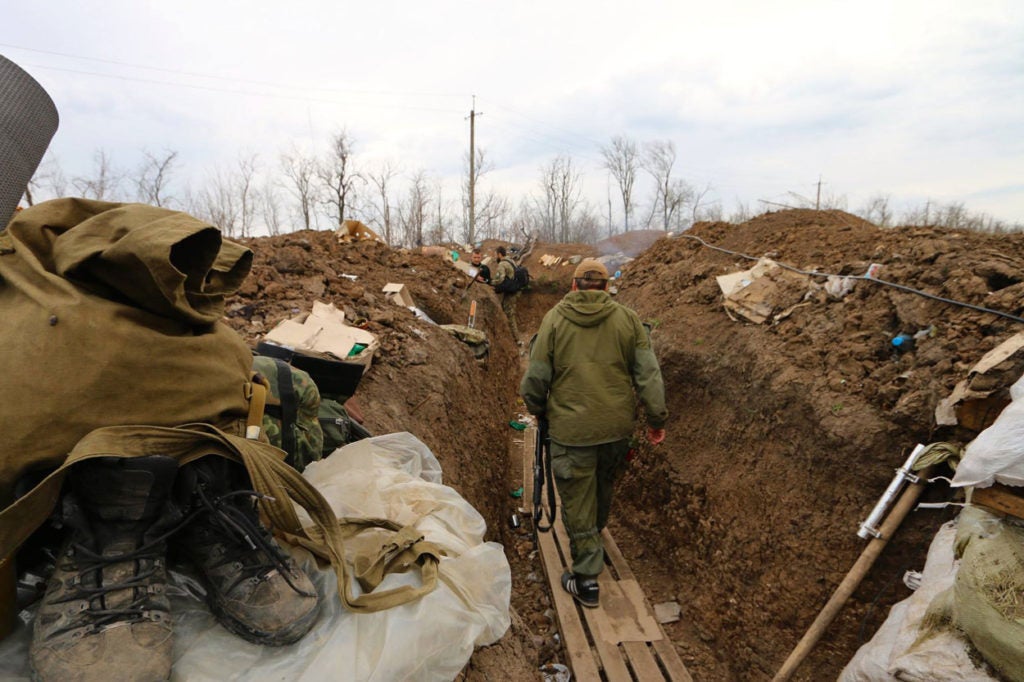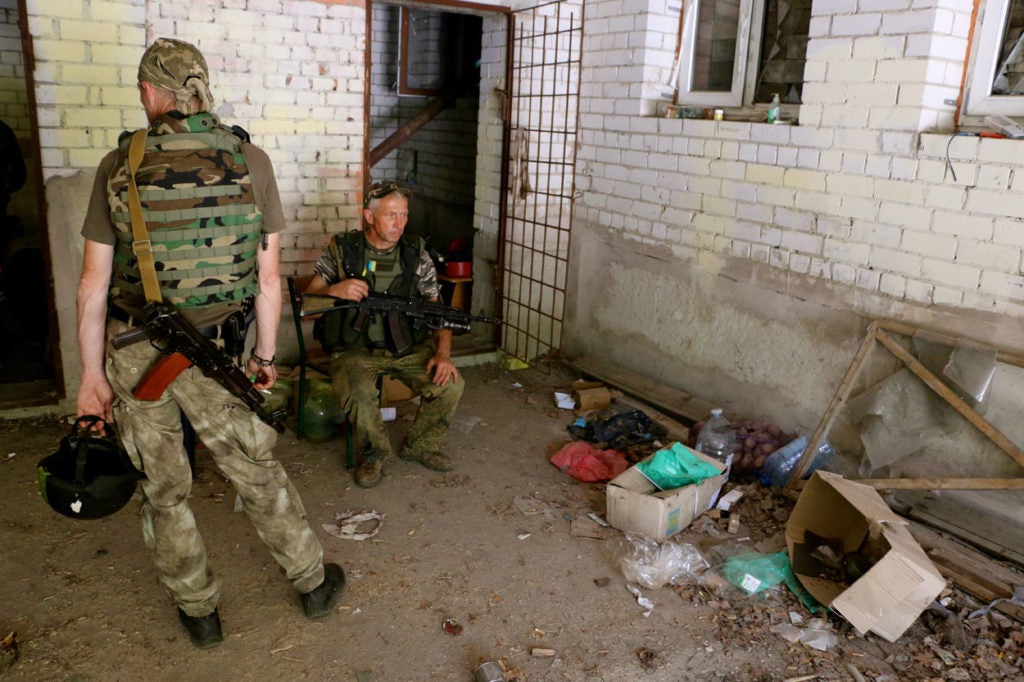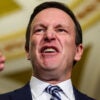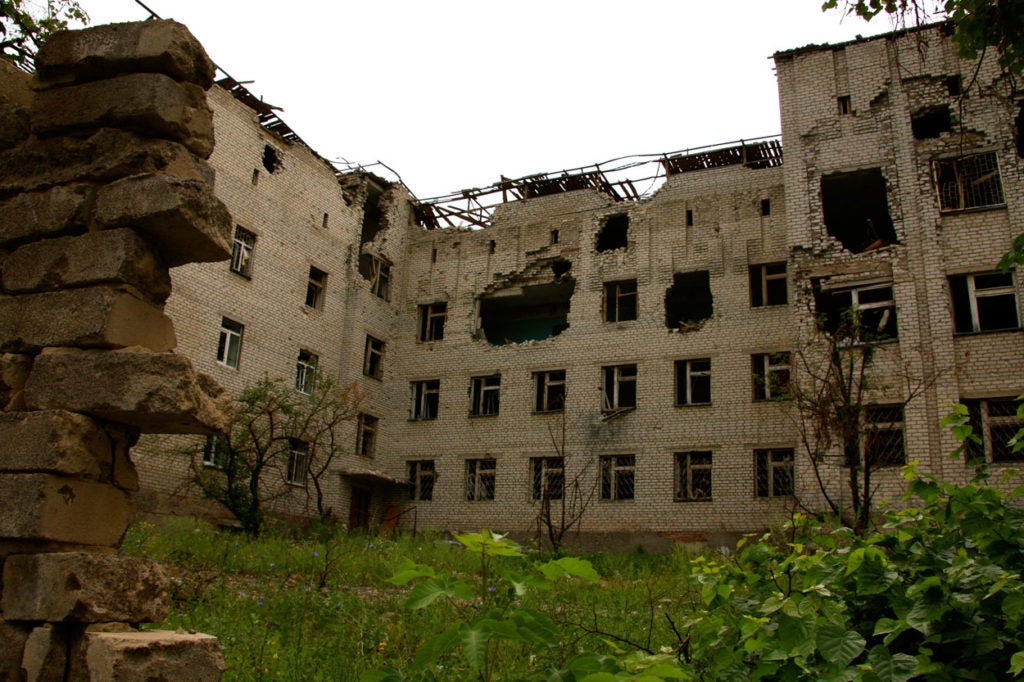KYIV, Ukraine—On Sunday, Europe’s two largest standing armies went to the precipice of a major war.
That day, Russian military forces attacked and captured three Ukrainian navy vessels that were transiting through the Russian-controlled Kerch Strait on their way from Ukraine’s Black Sea port of Odesa to Mariupol, on the Sea of Azov.
“This attack, of course, is not accidental. This is clearly an element planned by Russians in the escalation of the situation in the waters of the Sea of Azov, which has been lasting for several months. And I’m sure this is still not a culmination,” Ukrainian President Petro Poroshenko said Monday in remarks posted to his administration’s website.
The Daily Signal depends on the support of readers like you. Donate now
Sunday’s crisis is the culmination of months of Russia ratcheting up pressure on Ukrainian ships, both military and merchant, traveling across the Sea of Azov, which is a major trade artery for Ukraine.
Russia’s seizure of the three Ukrainian ships took the two erstwhile Soviet allies to the brink of all-out war on Sunday night. The incident had the hallmarks of a pre-planned, escalatory move by the Kremlin, experts say, raising concerns that the de facto stalemate in the ongoing ground war in the Donbas—which has contained the conflict to a static front line since February 2015—may be irreparably broken, and the war could metastasize into a much bigger, deadlier conflict.
The Kerch Strait crisis also scuttles any hope for better relations between Russia and the West in the near term, experts and officials say, and likely guarantees that punitive U.S. and European sanctions on Russia for its aggression against Ukraine will remain in place for a long time to come.
“As President Trump has said many times, the United States would welcome a normal relationship with Russia. But outlaw actions like this one continue to make that impossible,” U.S. Ambassador to the United Nations Nikki Haley said Monday at an emergency meeting of the United Nations Security Council.
As the crisis developed into Sunday night, Ukraine’s armed forces went on full alert.
“I can surely speak confidently—me and my comrades are ready. We’re just waiting for a final decision from the president,” Mykhailo Khiraldo-Ramirez, of Ukraine’s 318th Kyiv Territorial Defense Battalion, told The Daily Signal. The unit is one of a myriad of irregular, civilian partisan units charged with waging a guerilla war should Russia invade.
Poroshenko first convened his military cabinet at 10 p.m., and then he met with Ukraine’s National Security and Defense Council (NSDC) at midnight.
The NSDC was broadcast live and across the country Ukrainians sat glued before their television screens, unsure if their president was about to formally declare war on Russia.
It was a surreal moment with the gravest of stakes. Any military retaliation by Ukraine would likely spark a tit-for-tat escalatory back and forth with Russia, leading to all-out war.
Russia has roughly 77,000 troops forward deployed to its borders region near Ukraine, and those units are capable of launching a rapid, conventional invasion of Ukraine, analysts say. Moreover, there are also about 40,000 Russian troops currently deployed to Crimea, Ukrainian military officials say, and the Russian navy has about 40 ships assigned to the Sea of Azov.
Ultimately, Poroshenko opted not to declare war or to retaliate militarily against Russia. Rather, the Ukrainian president declared martial law for 60 days, pending a confirmatory vote by Ukraine’s parliament on Monday.
On Monday, Poroshenko amended the martial law declaration, reducing its duration to 30 days. He said he would decide in December on a date for Ukraine’s upcoming presidential elections, which are currently planned for March.
The martial law declaration is not set to expand the war in the Donbas, nor does it authorize offensive military action against Russia. Rather, it curtails certain civil liberties, expands police powers, and limits political activities to maintain civil order during an attack by an outside power.
After four and a half years of war, in which more than 10,300 Ukrainians have so far died, Poroshenko has never taken this extraordinary step. That changed on Sunday night, however, underscoring the gravity of the current crisis.
For his part, Poroshenko was careful to point out that martial law was not an attack on Russia.
“Martial law does not mean declaration of war. Ukraine has no plans to go to war with anyone,” Poroshenko said at Sunday’s late-night NSDC meeting.
Poroshenko added, “Martial law is introduced exclusively for the purposes of defense, protection of the Ukrainian land, our territorial integrity, our country’s sovereignty and independence.”
In the martial law gambit, Poroshenko was threading a narrow line—he had to send a message of strong leadership to a war-weary Ukrainian nation while not provoking a larger conflict with Russia.
“If the Ukrainian government does not respond properly, it will appear weak or incapable to Ukrainian society and empower the Kremlin’s preferred candidates in the coming elections,” Franklin Holcomb, a researcher specializing in Russian geopolitical affairs at the University of Tartu in Estonia, told The Daily Signal.
Chokepoint
Only Russia and Ukraine have coastlines on the Sea of Azov—a shallow-water sea that is a major trade artery for Ukraine.
The only route for ship traffic into the Sea of Azov is from the Black Sea through the Kerch Strait. In May, Russia opened a bridge over the Kerch Strait chokepoint. For that reason, all maritime traffic now has to pass under Russia’s new bridge.
Ukraine and Russia have established treaties regulating transit through the waterway, and Kyiv says the three captured vessels complied with all the necessary rules, including giving Russian authorities advance notice of their planned passage.
The Kerch Strait crisis began on Sunday afternoon when Russia accused the three Ukrainian navy vessels approaching the Kerch Strait of “illegally crossing the Russian border.” Those three vessels included two armored Gyurza-M class artillery boats, the “Berdyansk” and “Nikopol,” as well as the tug they were escorting, the “Yany Kapu.”

Front-line trenches outside the town of Shyrokyne, on the Sea of Azov shoreline in southeastern Ukraine.
The Ukrainian vessels did not file the necessary application for passage through the Kerch Strait, Russia’s Federal Security Service, or FSB, said. In response, a Russian coast guard ship rammed the Ukrainian tug and sealed off the Kerch Strait with a cargo ship, effectively blockading the Sea of Azov. Meanwhile, Russian attack helicopters and fighter jets flew overhead.
“The attack of the Russian military upon Ukrainian vessels is an act of military aggression,” said Oleksandr Turchynov, head of the National Security and Defense Council.
As the day waned, reports came in that the three Ukrainian vessels had come under fire from Russian forces after having pulled a U-turn and traveled back outside of 12 nautical miles from any land claimed by Russia. The breadth of territorial waters is typically 12 miles, according to United Nations law.
Eventually, the Ukrainian navy announced that Russian special forces boarding parties had seized the three Ukrainian vessels.
As of this article’s publication, altogether, 23 Ukrainian military personnel were taken prisoner and remain in Russian captivity, Kyiv said. Six of the Ukrainian prisoners were wounded in the attacks, Ukrainian officials said, noting that two were in serious condition.
War Clouds
Ukraine and Russia have been locked in a limited, static war for years—the result of Russia’s 2014 invasion of Ukraine’s southeastern Donbas region. Thus, Sunday’s escalation by Russia sparked fears in Ukraine that a much larger, deadlier catastrophe was imminent.
“We see that today the military units of the armed forces and the FSB of the Russian Federation attacked our navy, firing to kill,” Turchynov said. “That is why we are talking about the danger of provocations not only in the Black and Azov Seas, but also on land. We see the active preparations are underway of the Russian military units along our northern, eastern, and southern borders.”
Ukrainian soldiers deployed to the Sea of Azov region told The Daily Signal that they have been deployed to different seaside locations than usual due to the crisis, although for reasons of operational security those locations cannot be disclosed.
By all accounts, Ukraine’s military forces are massing and maneuvering to counter the threat of a Russian amphibious landing or an airborne invasion.
Many Ukrainian politicians worried that Sunday’s Kerch Strait crisis was the opening salvo in a new round of tensions with Russia, threatening to escalate and expand the ongoing war in the Donbas.
“Given the blatant arrogance and brutality of Russian aggressive actions, it is now likely possible that Russia plans further acts of aggression at sea or on the ground. We must be ready for this,” Ukrainian Foreign Minister Pavlo Klimkin tweeted Sunday night.
Meanwhile, as the crisis unfolded on Sunday, about 200 to 300 protesters gathered outside the Russian Embassy in Kyiv, launching fireworks and trying to light tires on fire amid the watchful presence of Ukrainian police personnel, on hand to prevent uncontrolled violence.
The protests continued into Monday and had spread to Russian consulates in Kharkiv and Odesa.
The protests underscore a worry shared by many experts—that the Kremlin could exploit the Kerch Strait crisis, and any Ukrainian overreaction to it, as a convenient pretext to escalate its ongoing war against Ukraine, which for the time being remains quarantined to the battlefields of eastern Ukraine’s embattled Donbas region.
“Russia’s primary objective in its multifaceted campaign against Ukraine continues to be the removal of pro-Western forces from the government and the installation of a pro-Kremlin, or Kremlin-cooperative, regime,” Holcomb said.
“Russia’s aggression on the Sea of Azov serves this end by forcing Ukraine to either accept humiliation and large economic costs, or risk triggering Russian military escalation,” Holcomb said.
International Response
The international community resoundingly condemned Russia’s actions at the Kerch Strait as provocative and a violation of international law.
On Sunday, Haley announced an emergency meeting of the U.N. Security Council on Monday.
“We strongly support Ukraine’s sovereignty and territorial integrity within its internationally recognized borders extending to its territorial waters,” Haley said at the Monday meeting of the body. “We express our deep concern over the incident which represent a dangerous escalation and violation of international law.”
Poroshenko spoke with NATO Secretary-General Jens Stoltenberg on Monday morning.
“The Secretary General expressed NATO’s full support for Ukraine’s territorial integrity and sovereignty, including its full navigational rights in its territorial waters under international law,” NATO said in an emailed statement about the meeting.
“Ukraine urges its allies and partners to take all necessary measures to deter the aggressor,” the Ukrainian Foreign Ministry said in a Monday statement.
New Front
With their new Kerch Strait bridge completed in May, Russian officials swiftly moved to limit the tonnage of ships passing through the maritime passageway. That move paralleled a spike in activity by Russian naval forces that began in April to board and harass merchant vessels traveling to and from Ukrainian ports in the Sea of Azov.
Russia’s aggression in the Sea of Azov has spurred Ukraine to shore up its defenses against the threat of a Russian amphibious invasion from either the Sea of Azov or Black Sea.
Along the Sea of Azov coastline, Ukraine has built a network of coastal defenses—in some places they look like something from a photo of Normandy in World War II.
Beginning in July, Poroshenko kick-started a plan to build up Ukraine’s naval strength and harden its coastal borders. Ukraine has since announced the creation of a new Marine brigade to defend its southern coastlines as well as a plan to stand up a new naval base on the Sea of Azov.

Ukrainian soldiers take a minute to rest during a combat patrol in the town of Pisky in eastern Ukraine.
Poroshenko also ordered the Ukrainian navy to rapidly build a new fleet of shallow-water gunboats—known colloquially as a “mosquito fleet”—armed with advanced anti-ship weapons. To that end, in September the U.S. Coast Guard handed over two of its decommissioned 110-foot armed cutters to Ukraine.
A February 2015 cease-fire, known as Minsk II, quarantined the ongoing war in the Donbas along a static 250-mile-long front line.
However, Russia’s aggression in the Sea of Azov this summer threatens to upheave the war’s uneasy status quo. Moreover, Sunday’s Kerch Strait crisis underscored how the war is not a civil war, nor is it about the future of the Donbas.
Rather, Russia is leveraging its military might over Ukraine in a gambit to retain its regional hegemony. Also, some say, military victories against Ukraine are a means for Russian President Vladimir Putin to consolidate his domestic popularity.
“The Kremlin is posturing against Ukraine in order to distract an increasingly frustrated Russian society, which is growing increasingly frustrated with Putin and his government,” said Holcomb, the University of Tartu researcher.
































